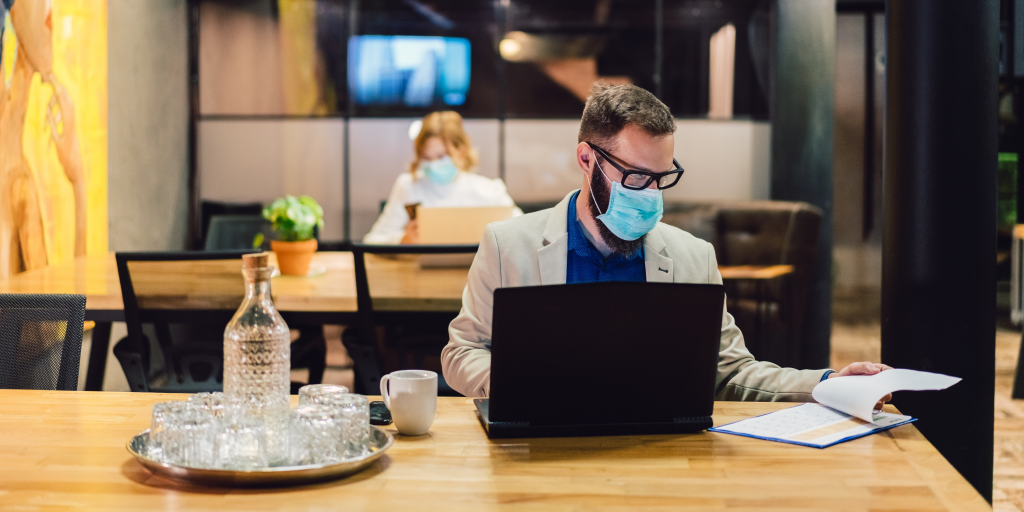Employee experience has been driving changes in the workplace for some time. As organisations come to realise the benefits of a more engaged and motivated team, business strategies increasingly focus on the experience of the people tasked with delivering success.
That experience is usually viewed in terms of the perks and benefits available in the office. The small differences that can set an employer apart
Now, however, it is taking on a new meaning. The challenge is to provide a consistent, meaningful experience for a workforce that is more dispersed than ever.
Where should employers start? How can they build on what they already have and adapt it for a new world of work? And how do they ensure they meet the needs of employees now and in the ever-evolving future?
The new, hybrid work model
The Covid-19 pandemic brought about a dramatic shift in how people work. Many had to quickly adapt to working from home and McKinsey & Company research showed 80% of people enjoy doing so. Nearly 70% said they were either as productive or more productive than before, so it’s clear they were able to fit work around that new dynamic.
But they did it because they had to.
Raj Verma, Senior Vice President of Human Resources at Sodexo, believes central workplaces will need to adapt, but their purpose is more than productivity. People proved they can work from home and many have enjoyed it, but ultimately, as humans they are “wired for social connection”.
“People are connecting virtually, but they don’t want to get used to it,” says Raj. “Just because you can have everyone working remotely doesn’t mean you should - you will lose the engagement.”

Changes were underway before the pandemic, as businesses came to realise how important a meaningful employee experience is. Putting people first, and prioritising their wellbeing and engagement in the design of spaces and activities, is key to success.
Raj has observed an acceleration in these trends, with companies forced to make decisions on policies and practices that might otherwise have taken years.
That observation is shared by Craig Murray, Workplace Strategy and Design Director at TSK Group. Sodexo partners with TSK Group on workplace design and transformation, and Craig believes organisations are about to take significant steps forward.
“We’ve seen iterative development over the last ten years, but people now have an expectation of flexibility in the way they work,” he says. “The office is going to be a key component to support culture, brand energy, and learning and development. Companies that don’t accelerate the pace of change are going to be less attractive as an employer.”
Meaningful engagement
Employers now have an opportunity to adapt the workplace, focusing even more on people and helping them make the decisions that will lead to the greatest benefits for the individual as well as the organisation.
“It is time to really think about how the workplace can better support the business,” says Yannick Villar, CEO of Wx – a subsidiary of Sodexo that helps businesses optimise spaces through data and technology.
“What will unleash the highest productivity and quality from your employees? Giving them the choice about how to work, or constraining them?”
A one-size-fits-all approach is unlikely to be sustainable as mindsets and expectations change, so understanding the specific needs of employees and what motivates them is key.
PwC recently outlined four types of workers in its own organisation and how their time spent in an office environment is changing. ‘Collaborators’, for example, usually work with others in a fixed location and have traditionally been in the office up to 80% of the time. ‘Wanderers’ are not tied to a single space and have variable schedules, so would have spent up to 60% of their time in an office. Now, according to PwC, these groups have respective targets of 50% and 40% of time in the workspace.

Yannick believes organisations will depend on employees’ willingness to come to the office, so they must be involved in deciding how it looks and works. Previously a Monday to Friday, 9 to 5 routine could be imposed, but employees now need to feel safe and in control of their environment and work schedules.
For many, this control will come from the understanding that much of their work can be carried out remotely, supported by the office as a place that offers something they can’t get elsewhere.
A place that embodies the culture of an organisation and helps build a strong and connected work community.
“The technology is often better at home anyway, so the workplace can become more analogue, a place people go for a fundamentally human experience,” says Craig.
PwC identified target times in the office for four persona types.
- Collaborator: 20-50%. Regularly collaborates with others in a fixed space, e.g. research scientist, engineer.
- Wanderer: 20-40%. Not tied to a single area in a company’s location, variable working patterns, e.g. marketing professionals, corporate support staff.
- Sentry: 80-100%. Work requires a dedicated location, e.g. receptionist.
- Rover: 0-10%. Often works away from the office, with no specific physical ties, e.g. field service specialist, sales representative.
Supporting more effective leaders
The shift to a hybrid model, with remote working coming as naturally as going to the office, means a greater focus on results. As people make more informed decisions about where they work and when, Raj believes flexibility will become the norm.
“It's all about outcomes,” he says. “What are we trying to achieve? It doesn’t bother me whether people work Monday, Wednesday, Thursday, Saturday, because you're making them responsible for what it is that they have agreed to deliver within a period of time.”

Effective leadership is essential to this transition. And managers need to be trained and supported in developing a new mindset, so they are empowered to create an environment in which people are stimulated and trusted.
With the right support, leaders can:
- Understand and embrace the ‘liquid’ workplace and the role different environments – the office, home and other remote locations – can play in delivering better results.
- Learn to become more flexible and adapt their leadership styles to a more remote team.
- Create a consistent experience, providing the tools and direction people need to carry out their work.
- Consider how and when people come together to collaborate most effectively, rather than bringing them into an office for its own sake.
Raj notes these points are particularly important to new employees, who will have limited opportunities to engage with the business and develop an appreciation of its values and culture if they only work remotely.
Organisations need to make their objectives clear and hire people to figure out how to get there. They don't want to be telling them how to get there.
Raj Verma, Senior Vice President of Human Resources at Sodexo
Practical changes in the workplace
As businesses consider the practical changes they can make in the workplace, there is a danger of focusing only on hygiene and physical distancing. But Yannick warns these are likely to be short-term concerns, particularly in the event of a vaccine entering circulation.
Instead, Wx and Sodexo are focusing on changes in mindsets, which are likely to prevail. People will take greater precautions and have different expectations of employers, how they look after their wellbeing, and how they provide what is needed to deliver results.
We're not going to go back to the office to collaborate for eight hours a day. So we need to make it more fluid, make it about the team and stimulating connections.
Craig Murray, Workplace Strategy and Design Director at TSK Group
That means redefining workplace strategy and design. Creating physical offices that act as hubs for collaboration and engagement, combined with remote “spokes” where people can access the services and facilities they need.
These spokes could be the home, a co-working space near home or a coffee shop. Travelling to the office will no longer be the default, and the onus will be on employers to provide the necessary solutions no matter where an employee wishes to work.

Vision, values and human connection
Office designs and layout have always moved through phases – from cubicles, to open plans and personalised desks, to the recent wave of hot desking. Now, Craig believes companies need to create spaces that truly foster collaboration.
This means focusing on their vision and values – what they are trying to achieve – and gathering information on how a space is used. More employers are coming to realise the importance of this understanding because it lays the foundation for effective change.
Ultimately, physical workspaces will be critical to the success of companies as we enter the ‘next normal’. Far from being replaced by home working habits, they will become critical hubs that support and enhance the human connection we need.
And as employers come to embrace a truly hybrid work model, employees will benefit from a consistent, meaningful experience no matter where they choose to work.
